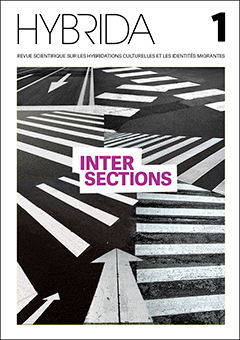Following the path of the nomad. The gypsy woman: myth, photography and self(re)presentation
DOI:
https://doi.org/10.7203/HYBRIDA.1.16871Keywords:
History of photography, representation, Spanish Romani women, visual stereotypes Abstract
Abstract
The article reflects a long investigation about the social representation of gitanas (Spanish Romani women). One of our working tools is photography within its relations with the previously established visual discourse. In this case, we inquire into the way of constructing the image of Otherness, carried out by French artists who visited Spain, more or less involved in the exotic paradigm. Later, some more experimental art trends tried other types of perspectives, not without difficulties. The second parameter we used was the self-representative response of contemporary Romani women. We developed and carried out a series of interviews with representatives of various Roma organizations in Spain (Valencia). These are women immersed in the task of reviewing many determining factors in their lives. Their responses regarding the two pillars of representation, language and image, have provided us with invaluable help and many surprises.
 Downloads
Downloads
 References
References
Andersen, H. Ch. (2005). Viaje por España. Alianza.
Appadurai, A. 2004. Minorities and the Production of Daily Pace. Interview with Arjun Appadurai, in J. Brouwer & A. Mulder (eds.), Feelings are Always Local. NAI Publishers.
Asociación de Mujeres Gitanas Alboreá. (s.d.). Promoviendo la igualdad de oportunidades. Consulté le 26.10.2018. https://www.asociacionmujeresgitanasalborea.org/mujer/
Asociación de Mujeres Gitanas Romi. (s.d.). ¿Quienes somos? Consulté le 14.02.2020. http://asociacionromi.org/quienes-somos
Asociación de Mujeres Gitanas ROMI. (1994). Problemática de la mujer gitana asociación de mujeres gitanas, in Federación de Organizaciones Feministas del Estado Español (éd.), Jornadas feministas (pp. 51-54). Federación de Organizaciones Feministas del Estado español.
Asociación Gitanas Feministas por la Diversidad. (s.d). Portada. Consulté le 12.11.2019. https://www.gitanasfeministas.org/quienesomos
Asociación Romi Serseni. (s.d.). Romi Serseni. Madrid: Romi Serseni Consulté le 16.05.2020. http://www.romiserseni.es/
Balzac, H. de. et al. Les Français peints par eux-mêmes: Encyclopédie morale du XIXe siècle (V Vol.). Paris.
Baroche, Ch. (1984). Lucien Clergue. Orbis.
Barthes, R. (1957). Mythologies. Seuil.
Bauman, Z. (2004). Identity: Conversations with Benedetto Vecchi. Polity Press.
Bessiere, B. (1992). La culture espagnole: les mutations de l’après-franquisme (1975–1992). L’Harmattan,
Bhabha, H. K. (1983). The Other Question. Screen, 24(6), 18-36.
Bialostocki, J. (1973). Estilo e iconografía: contribución a una ciencia de las artes. Barral.
Boehm, G. (2011). ¿Más allá del lenguaje? Apuntes sobre la lógica de las imágenes, in A. García Varas (ed.), Filosofía de la imagen (pp. 87-106). Ediciones Universidad de Salamanca.
Braidotti, R. (2004). Feminismo, diferencia sexual y subjetividad nómade. Gedisa.
Brooks, E. (2018, avril 20). Claiming Our Place. KIWit. Consulté le 2 juin 2020. https://www.kiwit.org/kultur-oeffnet-welten/positionen/claiming-our-place.html
Brooksbank-Jones, A. (1997). Women in contemporary Spain. Manchester University Press.
Butler, J. (1990). Gender trouble: feminism and the subversion of identity. Routledge.
Cabello, G. (2017). Entre historia del arte y práctica de las imágenes: aura y dolor de reminiscencias en Georges Didi-Huberman. Anthropos, 246, 146-163
Calafell, J. & Ulled, J. (2011). Barcelona gitana, 1954-1974. Jacques Leónard. La Fábrica.
Carrillo, C. (2003). La dona gitana del segle XXI. Educació social: Revista d’intervenció socioeducativa, 24, 86-91. https://www.raco.cat/index.php/EducacioSocial/article/view/165433
Charnon-Deutsch, L. (2004). The Spanish Gypsy: the history of a European obsession. Pennsylvania University Press.
Cortés-Tirado, L. & Garcia-González, H. (1999). El movimiento asociativo gitano: retos de futuro. Demófilo: Revista de cultura tradicional, 30, 207-232.
Davillier, Ch. (1874). L’Espagne, illustrée de 309 gravures dessinées sur bois par Gustave Doré. Librairie Hachette et Cie.
Derrida, J. (1972). Marges de la philosophie. Minuit.
Didi-Huberman, G. (2013). La imagen superviviente. Historia del arte y tiempo de los fantasmas según Aby Warburg. Abada.
Douglas, M. (1966). Purity and Danger. Routledge.
Fernández Cabezas, J. M. (2008). La mujer andaluza folklórica en películas españolas (1929-1993) a partir del estudio literario-cinematográfico de La Lola se va a los puertos, de Antonio y Manuel Machado. Incidencias de esta imagen andaluza en España dentro de la cultura de masas [tesis doctoral dirigida por Demetrio E. Brisset Martín]. Universidad de Málaga.
Fernández Vilches, G. (2007). Las representaciones de Carmen en el cine norteamericano [tesis doctoral dirigida por Vicente Sánchez Biosca]. Universitat de València.
Ferrer del Río, A. et al. (1843-1844). Los españoles pintados por sí mismos. Ignacio Boix.
Foucault, M. (1971). L’ordre du discours. Gallimard.
Foucault, M. (1983). Histoire de la sexualité. Gallimard.
Gadamer, H.-G. (1991). La actualidad de lo bello, Paidós.
Gallego Morell, A. (1995). Gitanos, pinturas y esculturas españolas: 1870-1940. Textos sobre los gitanos y lo gitano: estudio y antología. Comunidad de Madrid.
Gallardo-Saborido, E. J. (2017). Gitanas y charros, un amor de película: Cine entre España y América Latina entre los años 40 y 60. Andalucía en la historia, 55, 32-35.
García, H. (2003). Participació del poble gitano i moviment associatiu. Educació social: Revista d’intervenció socioeducativa, 24, 92-104. https://www.raco.cat/index.php/EducacioSocial/article/view/165434
Gervais, Th. & Morel, G. (2017). The Making of Visual News: A History of Photography. Bloomsbury Academic.
Gil, S. (2011). Nuevos feminismos, sentidos comunes en la dispersión: una historia de trayectorias y rupturas en el Estado español. Traficantes de Sueños.
Gil Estevan, M. D. & Solano, Ruiz, M. C. (2014). Madre y mujer gitana: «Joaquina la gitana», de Joaquín Sorolla. Cultura de los cuidados: Revista de enfermería y humanidades, 40, 116-120. https://rua.ua.es/dspace/bitstream/10045/43948/1/Cultura-Cuidados_40_15.pdf
Gilman, S. (1985). Difference and Pathology. Cornell University Press.
Giménez Adelantado, A. (2008). Metamorfosis: reflexiones sobre el asociacionismo de las mujeres gitanas en la década de los 90. O Tchatchipen: lil ada trin tchona rodipen romani = revista trimestral de investigación gitana, 61, 9-15.
Gombrich, E. (1992). Aby Warburg. Una biografía intelectual. Alianza.
González Castro, C. & Quesada Dorador, E. (2012–2013). Gitanos en el arte español. In Luces de bohemia: artistas, gitanos y la definición del mundo moderno [exposición] Gran Palais, París (26 de septiembre de 2012–14 de enero de 2013); Fundación Mapfre, Madrid (2 de febrero–5 de mayo de 2013).
Gramsci, A. (2009). Hegemony intellectuals and the state, in J. Storey (ed.), Cultural Theory and Popular Culture: A Reader (pp. 85-91). Ft Prentice Hall.
Green, Ch. (2008). The Memory Effect. Anachronism Time and Motion. Third Text, 22(6), 681-697. https://doi.org/10.1080/09528820802652391
Guasch, A. M. (2014). La memoria del otro en la era global. Revista de Estudios Globales y Arte Contemporáneo, 2(1), 81-91.
Guerrin, M. (2005, le 28 janvier). Mathieu Pernot, une visión en creux. Le Monde. https://www.lemonde.fr/archives/article/2005/01/28/mathieu-pernot-une-vision-en-creux_395997_1819218.html
Habermas, J. (1981). Teoría de la acción comunicativa, Taurus.
Habermas, J. (1981). Modernity versus Postmodernity. New German Critique, 22. https://doi.org/10.2307/487859
Halbwachs, M. (2004). La memoria colectiva. Prensa Universitaria de Zaragoza.
Hall, S. (1997). Representation: cultural representations and signifying practices. Sage.
Haraway, D. (1995). Ciencia, cyborgs y mujeres: la reinvención de la naturaleza. Cátedra,
Hübschmannová, M. (s.d.). Matéo Maximoff. Romabase. Consulté le 15.05.19. http://rombase.uni-graz.at/cgi-bin/art.cgi?src=data/pers/maximoff.en.xml
Hugo, V. (2000). Les orientales; Les feuilles d’automne. Librairie Générale Française (original publié en 1829).
Hugo, V (2001) Notre-Dame de Paris (original publié en 1831). The Project Gutenberg (consulté le 26 octobre 2018). http://www.gutenberg.org/ebooks/2610
Huguet Chanzá, J. (coord.) (2003). Las fotografías valencianas de J. Laurent. Ajuntament de València.
International Association of Women’s Museums (IAWM). (2019). Consulté le 14/06/2019. https://iawm.international
Instituto de Cultura Gitana. (2018). Portada. Consulté le 09.04.2019. https://institutoculturagitana.es/
Instituto de Cultura Gitana. (2020). Jean-Pierre Liégeois. Consulté le 10.05.20. https://institutoculturagitana.es/wp-content/uploads/2020/03/PREMIADOS-CULTURA-GITANA-8-ABRIL-DE-2020.pdf
Isnar, D. (1934). Gitanes. Miroir du Monde, 247, 532-535.
Jiménez Burillo, P. (2013). Luces de bohemia: artistas, gitanos y la definición del mundo moderno. Fundación Mapfre.
Joschke, Ch. (2017). L’histoire de la photographie sociale et documentaire dans l’entre-deux-guerres. Paris dans le contexte transnational. Perspective, 1(2017), 113-128. https://doi.org/10.4000/perspective.7197
Junghaus, T. & Sekely, K. (2007). Paradise Lost. The First Roma Pavilion: La Biennale di Venezia. Open Society Institute. https://www.opensocietyfoundations.org/publications/paradise-lost-first-roma-pavilion-venice-biennale
Léonard, Y. (dir.) (2011). Jacques Léonard, el payo Chac. Curt Ficcions Curt Produccions.
Liégeois, J.-P. (1987). Gitanos e itinerantes: datos socioculturales, datos sociopolíticos. Asociación Nacional Presencia Gitana.
Liégeois, J.-P. (2013). Roms et Tsiganes, une culture européenne. Marseille, Capitale européenne de la culture. http://www.presenciagitana.org/RomsetTsiganes-MP2013.pdf
Litvak, L. (2009). Gitanos, vagabundos y saltimbanquis: Representaciones del artista bohemio en la pintura (1840-1925). Estudios de Literatura General y Comparada. Literatura y alianza de civilizaciones: XVI Simposio de la SELGYC, 425-450.
López Fernández, M. C. (2002). Aproximación a la mujer marginada: las gitanas de Nonell, in M. T. Sauret Guerrero & A. Quiles Faz (coord.) Luchas de género en la historia a través de la imagen ponencias y comunicaciones (vol. 2, pp. 341-360). Diputación de Málaga, Centro de Ediciones de la Diputación de Málaga (CEDMA),
López Fernández, M. C. (2004). La imagen de la mujer en la pintura española de finales del Siglo XIX y principios del Siglo XX [Tesis doctoral dirigida por Valeriano Bozal Fernández]. Universidad Complutense de Madrid.
López Rodríguez, M. E. (2016). Cruzar la línea. La construcción de la identidad de género en el patriarcado gitano [Tesis doctoral dirigida por María Alexia Sanz Hernández]. Universidad de Zaragoza.
Llopis Llort, R. (2003). Acció social i poble gitano. Educació social: Revista d’intervenció socioeducativa, 24, 33-53. https://www.raco.cat/index.php/EducacioSocial/article/view/165430
Maalouf, A. (1998). Les Identités meurtrières. Grasset.
Martín Cáceres, M. J. (2010). El Museo Etnológico de la Mujer Gitana: un espacio social para hacer visible lo invisible. Her&Mus: heritage & museography, 3, 2010 (Ejemplar dedicado a: Mujeres y museos), 50-54. http://hdl.handle.net/10459.1/58115
Martínez Canet, R. (coord.) (2017). El país que va fascinar Juan Dieuzaide. Museu Valencià d’Etnologia.
McDowell, L. (1999). Gender, Identity and Place: Understanding Feminist Geographies. Polity Press.
Merimé, P. (1952). Carmen; Doble error. Espasa-Calpe (original publié en 1847).
Montoya Gabarri, A. (2002). Identidad de género y movimiento asociativo de la mujer gitana española. La vivienda, un espacio para la convivencia intercultural: II Jornadas IRIS: ponencias: 3, 4 y 5 de diciembre de 2001 (pp. 81-86). Consejería de Obras Públicas, Urbanismo y Transportes de la Comunidad de Madrid.
Morros Mestres, B. (2018). Erotismo, cuerpo humano y fecundidad en el Romancero Gitano de Lorca. Hispanic Research Journal: Iberian and Latin American Studies, 19(6), 595-619. https://doi.org/10.1080/14682737.2018.1537329
MSCBS. (2020). Consejo Estatal del Pueblo Gitano. Consulté le 30.03.2020. https://www.mscbs.gob.es/va/ssi/familiasInfancia/PoblacionGitana/ConPuebloGitano.htm
Olivares Marín, C. (2009). El gitano imaginario y la cristalización del mito. Gazeta de antropología, 25, 2. http://www.ugr.es/~pwlac/G25_37Carmen_Olivares_Marin.html
Pavilion, R. (2009). Artistas participantes en el pabellón gitano de la Bienal de Venecia, «El paraíso perdido». O Tchatchipen: lil ada trin tchona rodipen romani = revista trimestral de investigación gitana, 66, 41-47
Peña García, M. P. (2017). Asociacionismo Romaní en Europa como nuevo intermediario entre los Estados-naciones, las Instituciones supranacionales y las comunidades gitanas (tesis doctoral dirigida por Gunther Dietz & Angel Acuña Delgado). Universidad de Granada.
Pernot, M. (s.d.). Index. Mathieu Pernot. Consulté le 14.02.2018. http://mathieupernot.com/index.php
Pernot, M. (2017). Les Gorgan. Xavier Barral.
Plataforma Khetane. (2020a). Romani Pativ. Consulté 12/01/2020. http://rromanipativ.info
Plataforma Khetane. (2020b). Inicio. Consulté 12/01/2020. http://plataformakhetane.org
Pollock, G. (2007). Encounters in the virtual feminist museum : time, space and the archive (pp. 143-171). Routledge.
Rodríguez López-Ros, S. (2009). Romipén. La identitat gitana. Aproximació filosòfica a la identitat de les persones de cultura gitana (tesis doctoral). Universitat Ramon Llull.
Said, E. (2003). Orientalismo. Debolsillo, [1978].
Sánchez Medina, A. (2016). Els gitanos de Lita Cabellut. O Tchatchipen: lil ada trin tchona rodipen romani = revista trimestral de investigación gitana, 93, 48-55. https://dialnet.unirioja.es/servlet/articulo?codigo=5470374
Santino Spinelli, A. (2007). El mundo y el arte de un pueblo desconocido (y II). O Tchatchipen: lil ada trin tchona rodipen romani = revista trimestral de investigación gitana, 57, 46-52.
Skola Romani. (2020). Personalidades feministas. Consulté le 10/01/2020. https://www.skolaromani.org/aula-de-jovenes/personalidades-feministas/
Spinelli, S & Suárez Saavedra, P. (2001). Los gitanos y la música. O Tchatchipen: lil ada trin tchona rodipen romani = revista trimestral de investigación gitana, 36, 40-47.
Spivak, G. (2010). Can the subaltern speak? reflections on the history of an idea. Columbia University Press
Sierra-Alonso, M. (2018). Helios Gómez: la invisibilidad de la revolución gitana. Historia y política: Ideas, procesos y movimientos sociales, 40(83), 114. https://doi.org/10.18042/hp.40.04
Ulled, J. (2012). Mitad payo, mitad gitano. Ediciones Destino.
Vives-Ferrándiz, L. (2019). Pathos in Catalonia: the politics of images in the era of memes. Comparative cinema, 12, 22-37. https://doi.org/10.31009/cc.2019.v7.i12.02
Warburg, A. (2010). Atlas Mnemosyne. Akal.
Zoon, I. (2001). Participación social e institucional de los gitanos españoles. O Tchatchipen: lil ada trin tchona rodipen romani = revista trimestral de investigación gitana, 41, 17-26.
Downloads
Published
How to Cite
-
Abstract730
-
PDF (Français )1356
Issue
Section
License
![]()
All the documents in the OJS platform are open access and property of their respective authors.
Authors publishing in the journal agree to the following terms:
- Authors keep the rights and guarantee HYBRIDA the right to be the first publication of the document, licensed under a Creative Commons license Attribution-NonCommercial-ShareAlike 4.0 International (CC BY-NC-SA 4.0) that allows others to share the work with an acknowledgement of authorship and publication in the journal.
- Authors are allowed and encouraged to spread their work (once published) through electronic means using personal or institutional websites (institutional open archives, personal websites or professional and academic networks profiles) once the text has been published.
















